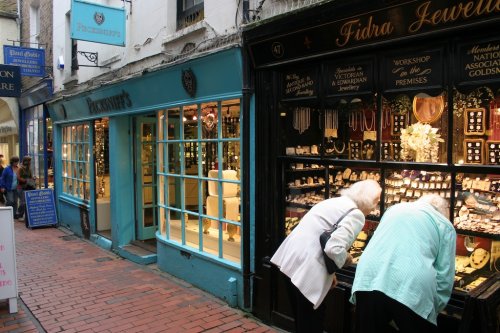Brighton began as a Saxon village on the southern coast of England. When the Saxons conquered Sussex in the 5th Century A.D., one of them was named Beorthelm. He owned a farm ("tun") called Beorthelm's tun which, in time became known as Brighton.
In 1313, Brighton was given a charter, granting the inhabitants certain rights. A fish market was held daily on the beach, and there was an annual fair.
The earliest map of Brighton shows a town of approximately a quarter of a mile square. It comprises North Street, West Street, East Street and South Street. The Lanes (which still exist today) were originally pathways between the four streets and the allotments or gardens in the centre. By 1500 Middle Street existed and there were fisherman's huts strung out along the shore.
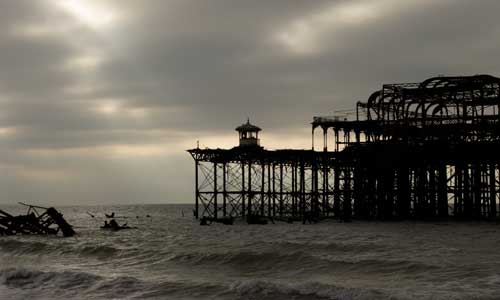
In 1545 a French invasion of Brighthamstead (Brighton) was driven back into the sea by the locals, and in 1651 Charles II was smuggled to the continent from the town after he unsuccessfully attempted to regain his crown at the Battle of Worcester.
By the early 17th Century Brighton was the largest town in Sussex with a population of nearly 4,000 people. The modern name of Brighton was first recorded in 1660, although it didn't become official until 1810.
| Advertisement |

|
| Click on Image |
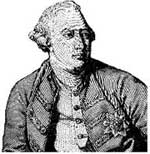 In 1750 Brighton's fortunes were revived by a paper published in Latin by Dr. Richard Russell (1687-1759),
advocating the bathing in and consumption of seawater as a medical cure for numerous glandular complaints,
along with asthma, consumption, rheumatism and even deafness (house shown below right).
In 1750 Brighton's fortunes were revived by a paper published in Latin by Dr. Richard Russell (1687-1759),
advocating the bathing in and consumption of seawater as a medical cure for numerous glandular complaints,
along with asthma, consumption, rheumatism and even deafness (house shown below right).
King George III (1738-1820) (shown right), who lost the American Revolutionary War and was often referred to as "the Mad" by his subjects, was the first monarch to embrace this advice and he regularly visited Weymouth to swim in the sea.
As the popularity of this remedy grew amongst the wealthy so, as the nearest coastal resort to Russell's hometown of Lewes, Brighton's visitor numbers increased dramatically as holidays by the sea became very fashionable. Brighton quickly became the most popular seaside retreat in Britain, attracting more than 2,000 visitors weekly to the town.
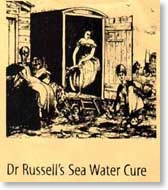 In 1753, Dr. Russell constructed an elaborate building on the southern side of the Old Steyne or Steine
(originally an open space used by fishermen to dry their nets) so that he could be nearer to his patients
during his summer practice. It was the largest house in Brighton at the time.
In 1753, Dr. Russell constructed an elaborate building on the southern side of the Old Steyne or Steine
(originally an open space used by fishermen to dry their nets) so that he could be nearer to his patients
during his summer practice. It was the largest house in Brighton at the time.
Dr. Richard Russell died in 1759, and his home was taken over by Dr. Anthony Relhan and let as a seasonal residence. George III's brother, the Duke of Cumberland, was a regular visitor for several years in the 1770s, where he was joined in 1783 by his nephew, George, Prince of Wales.
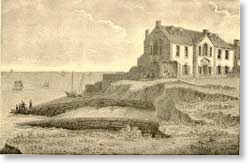 In the early 19th Century the building was briefly used as a boarding house run by a Mrs. Hill before being
converted for popular amusements, including Haine's Toy Repository and Puppet Theatre. However, by 1823 the
house had become dilapidated, and Dr. Russell's magnificent red-brick residence was demolished in 1823. The
town commissioners agreed to pay the current owner, solicitor and Magistrates' clerk John Colbatch, the
then-princely sum of £3,000 to allow the site to remain an open space to allow sea views from the
Royal Pavilion.
In the early 19th Century the building was briefly used as a boarding house run by a Mrs. Hill before being
converted for popular amusements, including Haine's Toy Repository and Puppet Theatre. However, by 1823 the
house had become dilapidated, and Dr. Russell's magnificent red-brick residence was demolished in 1823. The
town commissioners agreed to pay the current owner, solicitor and Magistrates' clerk John Colbatch, the
then-princely sum of £3,000 to allow the site to remain an open space to allow sea views from the
Royal Pavilion.
For some reason the deal was never completed, and so Colbatch built The Albion Hotel on the site. A plaque was eventually erected on the hotel's southern façade commemorating Dr. Russell. It reads: IF YOU SEEK HIS MONUMENT, LOOK AROUND.
